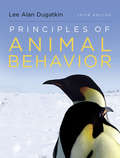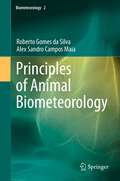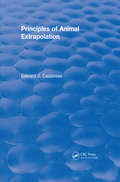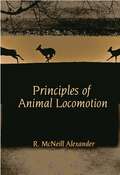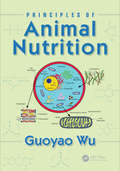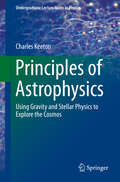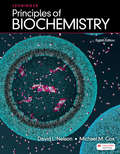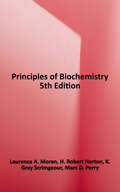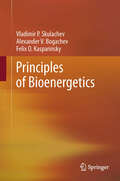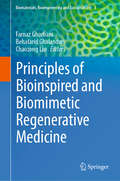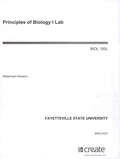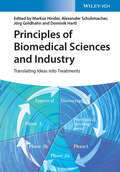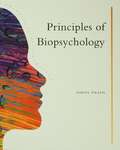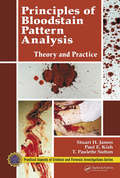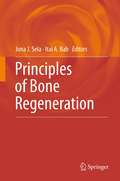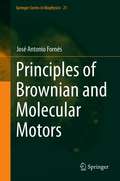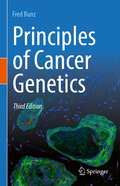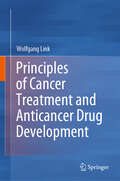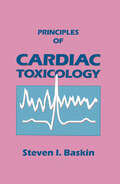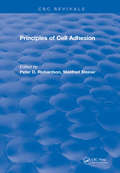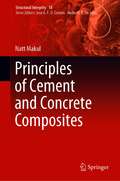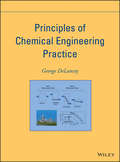- Table View
- List View
Principles of Animal Behavior
by Lee Alan DugatkinPrinciples of Animal Behavior has long been considered the most current and engaging introduction to animal behavior. The Third Edition is now also the most comprehensive and balanced in its approach to the theoretical framework behind how biologists study behavior.
Principles of Animal Behavior, 4th Edition
by Lee Alan DugatkinSince the last edition of this definitive textbook was published in 2013, much has happened in the field of animal behavior. In this fourth edition, Lee Alan Dugatkin draws on cutting-edge new work not only to update and expand on the studies presented, but also to reinforce the previous editions’ focus on ultimate and proximate causation, as well as the book’s unique emphasis on natural selection, learning, and cultural transmission. The result is a state-of-the-art textbook on animal behavior that explains underlying concepts in a way that is both scientifically rigorous and accessible to students. Each chapter in the book provides a sound theoretical and conceptual basis upon which the empirical studies rest. A completely new feature in this edition are the Cognitive Connection boxes in Chapters 2–17, designed to dig deep into the importance of the cognitive underpinnings to many types of behaviors. Each box focuses on a specific issue related to cognition and the particular topic covered in that chapter. As Principles of Animal Behavior makes clear, the tapestry of animal behavior is created from weaving all of these components into a beautiful whole. With Dugatkin’s exquisitely illustrated, comprehensive, and up-to-date fourth edition, we are able to admire that beauty anew.
Principles of Animal Biometeorology
by Roberto Gomes da Silva Alex Sandro Campos MaiaThe book begins by describing in detail the mechanisms of energy exchange - radiative, convective, conductive and evaporative - together with techniques for their determination. The discussion extends to the importance of CO2, ozone and methane, together with that of aerosol pollutants and the evolution of atmospheric CO2. Subsequent chapters apply the results of the biophysical methods to mammals, birds and aquatic animals. Discussion includes problems of shelter and shade for animals in tropical environments and techniques for the thermal evaluation for shelters and for several tree types. The details of heat exchange between animals and the environment are presented, in separate chapters covering Mammals and Birds and Aquatic Mammals. A chapter on Shade and Shelter describes the importance of shade for animals, factors of shade efficiency, the protections offered by shelter and methods of calculating the protection afforded by both shade and shelter. A Special Methods chapter offers a variety of techniques for evaluating cutaneous and respiratory evaporation, and practical methods for sampling of hairs and the evaluation of hair coat characteristics.
Principles of Animal Extrapolation: Principles Of Animal Extrapolation (1991) (CRC Press Revivals)
by Edward J. CalabresePrinciples of Animal Extrapolation addresses the conceptual basis for animal extrapolation and provides an abundance of documentation that illustrates how these principles may be applied in the selection of the more appropriate models and in the interpretation of toxicological studies. The book analyzes and documents each specific biological cause of interspecies differences in susceptibility to toxic agents, including differences in absorption, gut flora, tissue distribution, metabolism, mechanisms and efficiencies of repair, and excretion. The problem of the heterogenicity of the human population is addressed through several chapters that assess the availability and prospects of developing predictive animal models for normal humans, as well as selected potential high-risk groups. Other topics presented in this book include the biological basis of regulatory actions involving attempts to extrapolate from exceptionally high exposure levels to realistic values, especially carcinogens; an assessment of genotoxicity tests, their ability to predict carcinogenicity in whole animals, and the manner in which they should be used by regulatory agencies; birth defects; and predicting the risk of human teratogenesis. Principle of Animal Extrapolation is essential for environmental toxicologists. It also provides valuable information to biomedical scientists (especially those involved in drug development and testing) and regulatory personnel in agencies such as the EPA, the OSHA, the NIOSH, and the FDA.
Principles of Animal Locomotion
by R. McNeill AlexanderHow can geckoes walk on the ceiling and basilisk lizards run over water? What are the aerodynamic effects that enable small insects to fly? What are the relative merits of squids' jet-propelled swimming and fishes' tail-powered swimming? Why do horses change gait as they increase speed? What determines our own vertical leap? Recent technical advances have greatly increased researchers' ability to answer these questions with certainty and in detail. This text provides an up-to-date overview of how animals run, walk, jump, crawl, swim, soar, hover, and fly. Excluding only the tiny creatures that use cilia, it covers all animals that power their movements with muscle--from roundworms to whales, clams to elephants, and gnats to albatrosses. The introduction sets out the general rules governing all modes of animal locomotion and considers the performance criteria--such as speed, endurance, and economy--that have shaped their selection. It introduces energetics and optimality as basic principles. The text then tackles each of the major modes by which animals move on land, in water, and through air. It explains the mechanisms involved and the physical and biological forces shaping those mechanisms, paying particular attention to energy costs. Focusing on general principles but extensively discussing a wide variety of individual cases, this is a superb synthesis of current knowledge about animal locomotion. It will be enormously useful to advanced undergraduates, graduate students, and a range of professional biologists, physicists, and engineers.
Principles of Animal Nutrition
by Guoyao WuAnimals are biological transformers of dietary matter and energy to produce high-quality foods and wools for human consumption and use. Mammals, birds, fish, and shrimp require nutrients to survive, grow, develop, and reproduce. As an interesting, dynamic, and challenging discipline in biological sciences, animal nutrition spans an immense range from chemistry, biochemistry, anatomy and physiology to reproduction, immunology, pathology, and cell biology. Thus, nutrition is a foundational subject in livestock, poultry and fish production, as well as the rearing and health of companion animals. This book entitled Principles of Animal Nutrition consists of 13 chapters. Recent advances in biochemistry, physiology and anatomy provide the foundation to understand how nutrients are utilized by ruminants and non-ruminants. The text begins with an overview of the physiological and biochemical bases of animal nutrition, followed by a detailed description of chemical properties of carbohydrates, lipids, protein, and amino acids. It advances to the coverage of the digestion, absorption, transport, and metabolism of macronutrients, energy, vitamins, and minerals in animals. To integrate the basic knowledge of nutrition with practical animal feeding, the book continues with discussion on nutritional requirements of animals for maintenance and production, as well as the regulation of food intake by animals. Finally, the book closes with feed additives, including those used to enhance animal growth and survival, improve feed efficiency for protein production, and replace feed antibiotics. While the classical and modern concepts of animal nutrition are emphasized throughout the book, every effort has been made to include the most recent progress in this ever-expanding field, so that readers in various biological disciplines can integrate biochemistry and physiology with nutrition, health, and disease in mammals, birds, and other animal species (e.g., fish and shrimp). All chapters clearly provide the essential literature related to the principles of animal nutrition, which should be useful for academic researchers, practitioners, beginners, and government policy makers. This book is an excellent reference for professionals and a comprehensive textbook for senior undergraduate and graduate students in animal science, biochemistry, biomedicine, biology, food science, nutrition, veterinary medicine, and related fields.
Principles of Astrophysics
by Charles KeetonProvides a physics-centered analysis of a broad range of astronomical systems that appeals to a large audience of advanced undergraduate students in physics and engineering This book gives a survey of astrophysics at the advanced undergraduate level It originates from a two-semester course sequence at Rutgers University that is meant to appeal not only to astrophysics students but also more broadly to physics and engineering students The organization is driven more by physics than by astronomy; in other words, topics are first developed in physics and then applied to astronomical systems that can be investigated, rather than the other way around. The first half of the book focuses on gravity Gravity is the dominant force in many astronomical systems, so a tremendous amount can be learned by studying gravity, motion and mass The theme in this part of the book, as well as throughout astrophysics, is using motion to investigate mass. The goal of Chapters 2-11 is to develop a progressively richer understanding of gravity as it applies to objects ranging from planets and moons to galaxies and the universe as a whole. The second half uses other aspects of physics to address one of the big questions. While "Why are we here?" lies beyond the realm of physics, a closely related question is within our reach: "How did we get here?" The goal of Chapters 12-20 is to understand the physics behind the remarkable story of how the Universe, Earth and life were formed. This book assumes familiarity with vector calculus and introductory physics (mechanics, electromagnetism, gas physics and atomic physics); however, all of the physics topics are reviewed as they come up (and vital aspects of vector calculus are reviewed in the Appendix).
Principles of Biochemistry
by David L. Nelson Michael M. CoxLehninger's Principles of Biochemistry earned acclaim for its presentation and organization of complex concepts and connections, anchored in the principles of biochemistry. This legacy continues in the eighth edition with a new framework that highlights the principles and supports student learning.
Principles of Biochemistry, 5th Edition
by Marc D. Perry Laurence A. Moran H. Robert Horton K. Gray ScrimgeourPrinciples of Biochemistry provides a concise introduction to fundamental concepts of biochemistry, striking the right balance of rigor and detail between the encyclopedic volumes and the cursory overview texts available today. Widely praised for accuracy, currency, and clarity of exposition, the Fifth Edition offers a new student-friendly design, an enhanced visual program, new Application Boxes, contemporary research integrated throughout, and updated end-of-chapter problems.
Principles of Bioenergetics
by Alexander V. Bogachev Felix O. Kasparinsky Vladimir P. SkulachevPrinciples of Bioenergetics summarizes one of the quickly growing branches of modern biochemistry. Bioenergetics concerns energy transductions occurring in living systems and this book pays special attention to molecular mechanisms of these processes. The main subject of the book is the "energy coupling membrane" which refers to inner membranes of intracellular organelles, for example, mitochondria and chloroplasts. Cellular cytoplasmic membranes where respiratory and photosynthetic energy transducers, as well as ion-transporting ATP-synthases (ATPases) are also part of this membrane. Significant attention is paid to the alternative function of mitochondria as generators of reactive oxygen species (ROS) that mediate programmed death of cells (apoptosis and necrosis) and organisms (phenoptosis). The latter process is considered as a key mechanism of aging which may be suppressed by mitochondria-targeted antioxidants.
Principles of Bioinspired and Biomimetic Regenerative Medicine (Biomaterials, Bioengineering and Sustainability #3)
by Farnaz Ghorbani Behafarid Ghalandari Chaozong LiuNature has developed a diverse of materials, structures, and processes that are highly optimized for various functions. Through the field of biomimicry and bioinspiration, engineers are enhancing their understanding of natural design principles and applying these insights to create complex engineering models across different scales. These innovative approaches are particularly appropriate to address challenges in tissue engineering and regenerative medicine. Natural materials and systems exhibit a diverse array of functions, including but not limited to structural support, signal transduction, charge transfer, self-assembly, self-organization, and self-replication. Consequently, nature&’s "solution manual" is remarkably comprehensive. Despite significant advancements, the reconstruction of nature-inspired designs using synthetic materials presents ongoing challenges. As a result, nature and bioinspired materials and architectures have emerged as a paradigm shift within the realm of tissue engineering and regenerative medicine. This comprehensive guide aims to provide scientists with inspiration to address a variety of critical challenges in tissue regeneration by directly applying established design principles. A key focus of this volume is the utilization of bioinspired architectures in tissue engineering. It also emphasizes the development of nature-inspired structures through the integration of novel biological macromolecules, bioinspired polymers and hydrogels, as well as biomimetic ceramics. Furthermore, the text concentrates on the biochemical and biophysical dimensions of bioinspired surface engineering. Both dry-lab and wet-lab methodologies for characterizing nature and bio-inspired materials and structures are also addressed. The publication seeks to promote the development of high-level translational knowledge among both established and emerging scientists.
Principles of Biology I Lab
by Abdelmajid KassemWe have designed this laboratory manual for an introductory biology course with a broad survey of basic laboratory techniques. The experiments and procedures are simple, safe, easy to perform, and especially appropriate for large classes. Few experiments require more than one class meeting to complete the procedure. Each exercise includes many photographs and illustrations, traditional topics, and experiments that help students do biology as they learn about life. Procedures within each exercise are numerous and discrete so that an exercise can be tailored to the needs of the students, the style of the instructor, and the facilities available.
Principles of Biomechanics
by Ronald HustonResearch and study in biomechanics has grown dramatically in recent years, to the extent that students, researchers, and practitioners in biomechanics now outnumber those working in the underlying discipline of mechanics itself. Filling a void in the current literature on this specialized niche, Principles of Biomechanics provides readers with a so
Principles of Biomedical Ethics
by Tom L. Beauchamp James F. ChildressBuilding on the best-selling tradition of previous editions, Principles of Biomedical Ethics, Seventh Edition, provides a highly original, practical, and insightful guide to morality in the health professions. Acclaimed authors Tom L. Beauchamp and James F. Childress thoroughly develop and advocate for four principles that lie at the core of moral reasoning in health care: respect for autonomy, nonmaleficence, beneficence, and justice. Drawing from contemporary research--and integrating detailed case studies and vivid real-life examples and scenarios--they demonstrate how these prima facie principles can be expanded to apply to various conflicts and dilemmas, from how to deliver bad news to whether or not to withhold or withdraw life-sustaining treatments. Illuminating both theory and method throughout, Principles of Biomedical Ethics, Seventh Edition, considers what constitutes moral character and addresses the problem of moral status: what rights are due to people and animals, and when. It also examines the professional-patient relationship, surveys major philosophical theories--including utilitarianism, Kantianism, rights theory, and virtue theory--and describes methods of moral justification in bioethics. Ideal for courses in biomedical ethics, bioethics, and health care ethics, the text is enhanced by hundreds of annotated citations and a substantial introduction that clarifies key terms and concepts.
Principles of Biomedical Sciences and Industry: Translating Ideas into Treatments
by Alexander SchuhmacherPrinciples of Biomedical Sciences and Industry Improve your product development skills to bring new ideas to biomedicine The development of innovative healthcare products, such as biodegradable implants, biopharmaceuticals, or companion diagnostics, requires a multi-disciplinary approach that incorporates scientific evidence with novel and innovative ideas to create new and improved products and treatments. Indeed, product development and the integration of science with commercial aspects have become key challenges for scientists working in the pharmaceutical, biotech, and medtech industries. Using a multi-pronged approach to development, Principles of Biomedical Sciences and Industry combines ideas and methodologies from four of the central areas of focus in the biomedical arena: pharmaceuticals, diagnostics, biomaterials, and medical devices. In doing so, the book covers the entire product lifecycle, from translating a scientific idea into a prototype to product development, launch, and management. Principles of Biomedical Sciences and Industry readers will also find: Several case studies from the most important product categories (pharmaceuticals, diagnostics, medical devices, combination products) Chapters dealing with toxicology and safety risks in development, as well as regulatory approval Key business aspects including how to secure funding, managing intellectual property, and price regulation in the market An ideal resource for teachers and students that conveys the information in an easily-digestible format Ideal for advanced students and young professionals pursuing a career in the biomedical and healthcare industries, Principles of Biomedical Sciences and Industry is an essential reference for those in pharmaceutical industry, biotechnologists, medicinal chemists, bio-engineers, pharma engineers, and management consultants.
Principles of Biopsychology (Principles of Psychology)
by Nicky Hayes Michael Eysenck Simon GreenThis book is intended to provide an introduction to the basic structure and function of the brain and nervous system, emphasizing relationships with behaviour. The first chapter introduces the field, covering aims, objectives and ethical issues. In chapter 2 the neuron is described, and electrical and chemical conduction presented in detail; this chapter also introduces neurotransmitter pathways and drug effects on normal and abnormal behaviour.; After a general survey of the behavioural organization of the nervous system in chapter 3, three chapters describe how language, learning and memory are related to brain mechanisms, with a particular emphasis on clinical data from human patients, and functional assymetries between the hemispheres. The following chapter outlines the Involvement Of Arousal Systems In Stress, Anxiety And Emotion, And Also covers stress reduction techniques. The arousal theme is maintained in chapter 8 in which sleep is discussed in the context of biological rhythms in psychological and physiological processes.; Chapter 9 covers The Biological Bases Of Motivational States Such As Hunger And Thirst, and discusses the concept of homeostasis. Non-homeostatic drives such as electrical self-stimulation of the brain are also considered. Finally, chapter 10 reviews sensory processes in general, and then concentrates on pain perception and the brain mechanisms underlying visual sensation and perception.; It is intended that the material in this book should satisfy the requirements of both the A-level syllabus for Psychology, whichever Board is taken, and first year introductory undergraduate courses in psychobiology.
Principles of Bloodstain Pattern Analysis: Theory and Practice (Practical Aspects Of Criminal And Forensic Investigation Ser.)
by Stuart H. James Paul E. Kish T. Paulette SuttonAs witnessed in landmark criminal cases, the quality and integrity of bloodstain evidence can be a crucial factor in determining a verdict.
Principles of Bone Regeneration
by Jona J. Sela Itai A. BabPrinciples of Bone Regeneration is a timely publication that addresses the modern aspects of bone healing and repair. This exciting new volume details the convergence of the different experimental and clinical approaches designed for the study and treatment of bone healing in its diverse forms and under varying conditions. Bone healing is affected by a multitude of genetic, environmental, mechanical, cellular and endocrine variables which eventually lead to changes in gene expression that enhance the guided action of osteoblasts (and chondroblasts) to lay down bone that restores, or even improves, the skeletal load bearing capacity. Recent breakthroughs in understanding the regulatory aspects of bone formation and resorption, in both research and clinical arenas offer new modalities to induce, enhances and guide repair processes in bone for the benefit of millions of patients with conditions such as nonunion fractures, critical size defects, orthodontic tooth movement, periodontal bone loss, intraosseous implants and deformed bones.
Principles of Brownian and Molecular Motors (Springer Series in Biophysics #21)
by José Antonio FornésMolecular motors convert chemical energy (typically from ATP hydrolysis) to directed motion and mechanical work. Biomolecular motors are proteins able of converting chemical energy into mechanical motion and force. Because of their dimension, the many small parts that make up molecular motors must operate at energies only a few times greater than those of the thermal baths. The description of molecular motors must be stochastic in nature. Their actions are often described in terms of Brownian Ratchets mechanisms. In order to describe the principles used in their movement, we need to use the tools that theoretical physics give us. In this book we centralize on the some physical mechanisms of molecular motors.
Principles of Cancer Genetics
by Fred BunzThis popular textbook, now in its third edition, provides a theoretical framework for understanding why cancers arise, how they develop and how they can be treated.Particular attention is devoted to the origins of cancer and the application of evolutionary theory to explain how mutant cell populations tend to expand and spread. Focused on the genes and signaling pathways involved in the most common tumors, Principles of Cancer Genetics is a highly readable account that will be of interest to anyone who would like to attain a basic understanding of cancer biology. Students who have completed introductory coursework in genetics, biology and biochemistry, medical students and medical house staff will find this book to be a useful starting point toward mastery of this complex but fascinating topic. This updated edition delves into the critical interactions between growing tumors and the immune system, and introduces the concepts of T cell activation, immunoediting and immune evasion. Novel strategies for cancer diagnosis and prognosis, including new roles for next-generation sequencing and liquid biopsies, as well as established and emerging therapeutic modalities are now described in detail.For laypersons, students and researchers in other fields with a general interest in cancer, this book provides an accessible overview, enriched with many easy-to-understand illustrations. For advanced students considering future study in the field of oncology and cancer research, this concise book is a useful guide to the basic principles that underlie our understanding of cancer.
Principles of Cancer Treatment and Anticancer Drug Development
by Wolfgang LinkThis book explains how current medicines against cancer work and how we find new ones. It provides an easy-to-understand overview of current options to treat patients with cancer, which includes Surgery, Radiation therapy, Chemotherapy, Targeted therapy and Immunotherapy. The efficiency of all these treatments is limited by the capacity of cancer cells to escape therapy. This book explains the mechanisms of anti-cancer drug resistance and strategies to overcome it. The discovery and development process of a new drug is detailed beginning with the identification and validation of a therapeutic target, the identification of an inhibitor of the target and its subsequent preclinical and clinical development until its approval by regulatory authorities. Particular emphasis has been given to specific aspects of the development process including lead generation and optimization, pharmacokinetics, ADME analysis, pharmacodynamics, toxicity and efficacy assessment, investigational new drug (IND) and new drug application (NDA) and the design of clinical trial and their phases. The book covers many aspects of modern personalized oncology and discusses economic aspects of our current system of developing new medicines and its impact on our societies and on future drug research. The author of this book, Dr. Link counts with more than 20 years of experience in biomedical research reflected in numerous publications, patents and key note and plenary presentations at international conferences. Interested readers, students and teachers should read this book as it provides a unique way to learn/teach about basic concepts in oncology and anti-cancer drug research.
Principles of Cardiac Toxicology
by Steven I. BaskinWhat chemicals are poisonous to the heart and why are they toxic?Find out by reading Principles of Cardiac Toxicology. Certain chemicals can produce toxicity by interacting with elements of the cardiovascular system. This book presents the anatomical, physiological, biochemical, and pathological basis for this interaction and describes the
Principles of Cell Adhesion (CRC Press Revivals)
by Peter D. Richardson Manfred SteinerIntended for cell biologists, biophysicists, biochemists, molecular biologists, physiologists, researchers in hemostatsis and thrombosis and pathologists, this book provides an insight into cell adhesion from three interdisciplinary perspectives: fundamental facts of adhesion; molecular biochemistry of adhesion and physiological aspects. It summarizes the basic aspects of surfaces in general and describes the theoretical and experimental tools necessary to investigate cell adhesion, including the basic biochemistry and molecular biology of adhesion. The book offers concise treatment of individual topics, features current material, and provides key references as a guide to further study.
Principles of Cement and Concrete Composites (Structural Integrity #18)
by Natt MakulThis book presents an introduction, a discussion of the concept of the design and the concrete’s development, and the properties and testing of the concrete in fresh and hardened stages. After an introduction to the principles of cement and concrete composites, the reader will find information on the principles of quantum-scaled cement, low-carbon cement, fiber-reinforced concrete, reactive powder concrete, and tailor-made recycled aggregate concrete.
Principles of Chemical Engineering Practice
by George DelanceyEnables chemical engineering students to bridge theory and practiceIntegrating scientific principles with practical engineering experience, this text enables readers to master the fundamentals of chemical processing and apply their knowledge of such topics as material and energy balances, transport phenomena, reactor design, and separations across a broad range of chemical industries. The author skillfully guides readers step by step through the execution of both chemical process analysis and equipment design.Principles of Chemical Engineering Practice is divided into two sections: the Macroscopic View and the Microscopic View. The Macroscopic View examines equipment design and behavior from the vantage point of inlet and outlet conditions. The Microscopic View is focused on the equipment interior resulting from conditions prevailing at the equipment boundaries. As readers progress through the text, they'll learn to master such chemical engineering operations and equipment as:Separators to divide a mixture into parts with desirable concentrationsReactors to produce chemicals with needed propertiesPressure changers to create favorable equilibrium and rate conditionsTemperature changers and heat exchangers to regulate and change the temperature of process streamsThroughout the book, the author sets forth examples that refer to a detailed simulation of a process for the manufacture of acrylic acid that provides a unifying thread for equipment sizing in context. The manufacture of hexyl glucoside provides a thread for process design and synthesis.Presenting basic thermodynamics, Principles of Chemical Engineering Practice enables students in chemical engineering and related disciplines to master and apply the fundamentals and to proceed to more advanced studies in chemical engineering.
